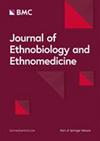埃塞俄比亚西部贝尼尚古尔-古穆兹地区州梅特克尔区迪巴蒂地区药用植物的人种植物学研究
IF 3.7
2区 医学
Q1 BIODIVERSITY CONSERVATION
引用次数: 0
摘要
自古以来,草药一直被用于治疗人类和牲畜的疾病。埃塞俄比亚的许多农村和城市社区都在使用传统医药,并代代相传。因此,本研究旨在记录埃塞俄比亚西部贝尼尚古尔古穆兹地区州梅特克尔区迪巴蒂地区的传统药用植物和相关本土知识。从 11 个 kebeles(最小的行政单位)中选取了 374 名信息提供者参与数据提供。民族植物学数据收集采用了半结构式访谈、偏好排序、直接矩阵排序、实地观察、市场调查和焦点小组讨论,包括凭证标本采集。民族植物学数据的分析采用了描述性统计(频率和百分比)、排序、比较和定量民族植物学技术,如信息提供者共识因子、忠实度指数、雅卡德相似系数和使用价值指数。共记录了 170 种植物,用于治疗 79 种人类疾病和 29 种牲畜疾病。豆科(20 种)和菊科(18 种)是该地区最主要的药用植物科。大多数药用植物是草本植物(61 种,占 35.88%),其次是灌木(39 种,占 22.94%)。大多数药用植物(135 种,79.41%)采自野生来源,主要有多种药用部位(41.17%),通常以新鲜形式(60.13%)处方。最常报告的人类疾病是蛇毒,而牲畜疾病中最常报告的是黑脚病。草药多为口服药(52.20%),其次是皮肤用药(17.62%)。Embelia schimperi Vatke、Glinus lotoides L.、Haplosciadium abyssinicum Hochst.、Mucuna melanocarpa Hochst.Rich. 和 Phragmanthera macrosolen (Steud. ex A. Rich.) M.G.Gilbert 对相应疾病的忠实度值最高(100%)。研究地区拥有丰富多样的潜在药用植物和相关的本土知识。因此,必须采取适当的保护措施并谨慎利用,以抵御不断增加的人为威胁,并确保植物与相关本土知识的延续性。此外,应通过实验对药用植物进行验证,将当地知识与现代药物相结合。本文章由计算机程序翻译,如有差异,请以英文原文为准。
Ethnobotanical study of medicinal plants in Dibatie district, Metekel zone, Benishangul Gumuz Regional State, western Ethiopia
Herbal medicine has been used for the treatment of human and livestock ailments since ancient times. Numerous rural and urban communities in Ethiopia practice traditional medicine and transfer the knowledge verbally from generation to generation. Thus, this study was conducted to document the traditional medicinal plants and associated indigenous knowledge in Dibatie district, Metekel zone, Benishangul Gumuz Regional State, western Ethiopia. Three hundred seventy-four (374) informants from 11 kebeles (the smallest administrative units) were selected and participated in the data delivery. The ethnobotanical data collection was carried out using semi-structured interviews, preference ranking, direct matrix ranking, field observation, market surveys, and focus group discussions, including voucher specimen collections. The ethnobotanical data were analyzed using descriptive statistics (frequency and percentage), ranking, comparison, and quantitative ethnobotanical techniques such as informant consensus factor, fidelity level index, Jaccard’s coefficient of similarity, and use value index. A total of 170 plant species were recorded to treat 79 human and 29 livestock ailments. Fabaceae (with 20 species) and Asteraceae (with 18 species) were the most dominant medicinal plant families in the area. Most remedial plants were herbs (61 species, 35.88%), followed by shrubs (39 species, 22.94%). The majority (135 species, 79.41%) of medicinal plants were harvested from wild sources and mainly possessed multiple remedy parts (41.17%) that are usually prescribed in fresh form (60.13%). The most commonly reported human ailment was snake venom, while blackleg was mostly reported among livestock diseases. The herbal medicines were mostly administered orally (52.20%), followed by dermal (17.62%) application. Embelia schimperi Vatke, Glinus lotoides L., Haplosciadium abyssinicum Hochst., Mucuna melanocarpa Hochst. ex A. Rich., and Phragmanthera macrosolen (Steud. ex A. Rich.) M.G.Gilbert had the highest fidelity level values (100%) against the corresponding ailments. The study area is rich in a diversity of potential medicinal plants and associated indigenous knowledge. Thus, appropriate conservation actions and careful utilization are essential to counteract the rise of anthropogenic threats and to ensure the continuity of plants with the related indigenous knowledge. Additionally, the medicinal plants should be validated through experimentation to integrate local knowledge with modern medications.
求助全文
通过发布文献求助,成功后即可免费获取论文全文。
去求助
来源期刊

Journal of Ethnobiology and Ethnomedicine
PHARMACOLOGY & PHARMACY-
CiteScore
7.30
自引率
16.70%
发文量
66
审稿时长
>12 weeks
期刊介绍:
Journal of Ethnobiology and Ethnomedicine publishes original research focusing on cultural perceptions of nature and of human and animal health. Journal of Ethnobiology and Ethnomedicine invites research articles, reviews and commentaries concerning the investigations of the inextricable links between human societies and nature, food, and health. Specifically, the journal covers the following topics: ethnobotany, ethnomycology, ethnozoology, ethnoecology (including ethnopedology), ethnogastronomy, ethnomedicine, ethnoveterinary, as well as all related areas in environmental, nutritional, and medical anthropology.
Research focusing on the implications that the inclusion of humanistic, cultural, and social dimensions have in understanding the biological word is also welcome, as well as its potential projections in public health-centred, nutritional, and environmental policies.
 求助内容:
求助内容: 应助结果提醒方式:
应助结果提醒方式:


